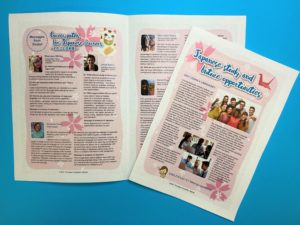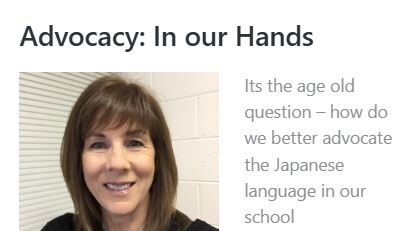ADVOCACY
This page provides a collection of videos and website links related to advocacy. Feel free to explore these resources and use them as a reference to deepen your understanding or support your initiatives. I hope you find them helpful!
WHY LEARN JAPANESE?
Over the last 100 years, Australia has developed a deep and lasting relationship with Japan, not only politically and through trade, but on a grassroots, person–to-person level. Japan’s rich culture, both ancient and modern, holds a fascination for us and our students, and we are drawn to the ‘soft power’ of Japanese culture in the form of manga, anime, art, music, fashion and food. For many students, meeting Japanese people or staying in Japan has been a memorable and life-changing experience. Australians work closely with Japanese companies, organisations and individuals in various areas, and there are many opportunities for work related connections in the future.
WHY STUDY JAPANESE AT UNIversity?
The following two videos are published by Japanese Studies Association on Australia to promote Japanese language education at university.
The ULPA (University Languages Portal Australia) featured in the video provides useful information on language program at universities across Australia.
Please visit the website. https://ulpa.edu.au/
Where do Japanese Language Learners End Up?
The following two videos are published by Monash Japanese Language Education Centre. Go to “Learn Japanese and a New World Opens Project” 日本を知る、世界が広がる。for more information and videos.
Other Resources for Advocacy
- The Japan Foundation, Sydney: Advocacy kit



 The Japan Foundation, Sydney has created a kit for teachers to use for promoting their Japanese language programs. It contains advocacy brochure, advocacy PowerPoint presentation, and advocacy flyer. This colourful brochure contains a variety of information about Japanese traditional and modern culture and aims to inspire students to study Japanese.
The Japan Foundation, Sydney has created a kit for teachers to use for promoting their Japanese language programs. It contains advocacy brochure, advocacy PowerPoint presentation, and advocacy flyer. This colourful brochure contains a variety of information about Japanese traditional and modern culture and aims to inspire students to study Japanese.
- The Japan Foundation, Sydney: Sensei’s Voices

The website provides articles contributed by teachers and educators on events and programs advocating Japanese language learning to the school community and beyond. Please share your experiences and any ideas with your colleagues! Here are some example articles below. For more articles please visit Sensei’s Voices
Program Resources and Support
- Embassy of Japan in Australia, Canberra

Embassy and school visits – staff introduce aspects of Japanese culture and society through DVDs, plastic food displays, traditional toys and clothing. Embassy visits include a tour of a Japanese garden. DVDs and cultural items are also available for loan. - Consulate-General of Japan in Sydney

School visit program – includes a calligraphy workshop and general presentation – introduction to Japan. - Consulate-General of Japan in Brisbane

School visit program – topics include Japanese food, children’s games and toys, traditional arts and crafts, traditional clothing and contemporary fashion, school life, and careers using Japanese language. DVDs and cultural items are also available for loan. - Consulate-General of Japan in Melbourne

Cultural seminars – topics include visual and performing arts, pop culture, school, leisure, food, customs, and tourist destinations. DVDs and cultural items are also available for loan. - Consulate-General of Japan in Perth

Organisers of events can apply for nominal support. - The Japan Foundation, Sydney
Center Visit Program
Japanese Classroom Resources
Information for teachers of Japanese
- The Japan Foundation, London
Teaching and Learning Resources
- The Japan Foundation, Los Angeles
Information for teachers
- Japan National Tourism Organization (JNTO) Australia
Brochures and maps of Japan
School Partnerships, Trips and Exchanges
- Council of Local Authorities for International Relations (CLAIR) Sydney

Information on International Exchange - Japan National Tourism Organization (JNTO) Australia

Information on school trips to Japan - AFS Australia

Offers 1-2 month, 1-semester, and 1-year student exchange programs. - Southern Cross Cultural Exchange (SCCE)

Offers 2-month, 3-month, 1-semester, and 1-year student exchange programs. Students must have been studying Japanese for at least two years to be considered for the program. - Youth for Understanding (YFU) Student Exchange

Offers 2-month, 3-month, 1-semester, and 1-year student exchange programs. Students must have been studying Japanese for at least one year prior to departure.
Japanese at Tertiary Level
To find tertiary institutions offering Japanese language studies, please use the Japan Foundation’s search engine for institutions offering Japanese-language education. *This data is based on the JF Survey Report, conducted every three years.
Future Learning Opportunities and Careers
- Australian Embassy, Tokyo, Japan: Studying in Japan

Information about opportunities to study or research in Japan. - MEXT Scholarship

Various scholarships offered to Australian university students and school teachers to study in Japan. - JET Programme

An exchange program where participants work in local governments or private schools in Japan as Assistant Language Teachers (ALTs), Sports Exchange Advisors (SEAs), or Coordinators for International Relations (CIR). - Ministry of Foreign Affairs of Japan: Working Holiday Programmes in Japan

A program that provides opportunities for young people to engage in employment while on holiday in Japan. - Australia-Japan Youth Association

An organisation that provides a platform for young people from Australia and Japan to connect and discover professional opportunities that promote Australia-Japan relations. - JETRO Australia: business information

A Japanese government organisation that provides free business support services to companies expanding to Japan. - The Government of Japan: Open for business working in Japan

Stories of entrepreneurs who have forged successful careers in Japan.
The Japan Foundation, Sydney (June 2025)
















